Edge Sorting Three Card Poker

Three Card Poker (3CP) is a tough game to beat for the hole-carding AP. As this post shows, a near perfect read of one hole-card is not enough to gain a reliable edge. Ten years ago, APs found opportunities to view multiple hole-cards. There were a lot of good times. Nowadays, the “hole-card” good times have shifted away from 3CP on to Mississippi Stud and other lucrative proprietary games. However, there is a more sophisticated method that some APs are using to beat 3CP: edge sorting (see this post or this post). Using asymmetric defects in the cut and design of the cards, the AP may be able to distinguish between two subsets of cards. Using the information gained from knowing which group each of the dealer’s cards belongs, the AP can gain an advantage.
In the case of 3CP, the cards are rotated into one of the following two subsets:
- High cards (H) = {Q, K, A}
- Low cards (L) = {2, 3, 4, 5, 6, 7, 8, 9, T, J}
This breakdown into these specific high and low subsets is intuitively clear. The high cards are precisely those cards that insure the dealer will qualify.
Once the cards are sorted, the AP will look at the back of the dealer’s cards before making the decision to fold or play. Depending on how the dealer’s cards are placed face-down on the table and the quality of the card irregularities, the AP may be able to distinguish 0, 1, 2 or all 3 of the dealer’s cards as high or low.
The following table gives the edge for the AP based on the number of cards the AP can distinguish:
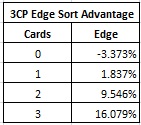
Distinguishing only one card gives the AP an edge of 1.837% over the house. However, this is not sufficient for most APs. The AP who plays this way will suffer from ills similar to the one-hole-card game. The variance will be extreme. Mistakes will eat away a lot of the AP's edge. Hands where the AP misses the read as well as cover play will cost the rest.
The following table gives the strategy for the AP based on the number of cards he can distinguish as high or low. Under the “Strategy” column, I list the minimum hand the AP should play. He should fold all hands less than the indicated hand. In reading this table, the letter “X” denotes an unknown card.
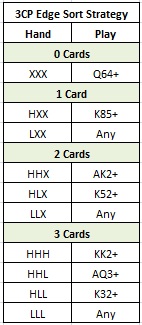
The following tables give the full combinatorial analysis for these four situations. Note that “0 Cards” is the same as the base game, with a house edge of 3.3730%.
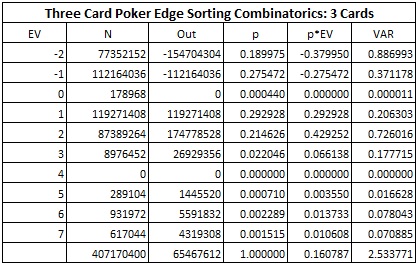
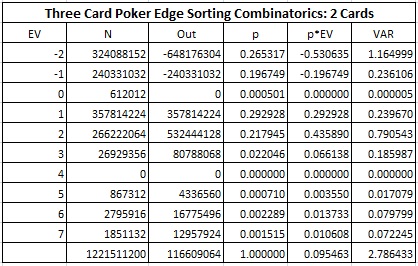
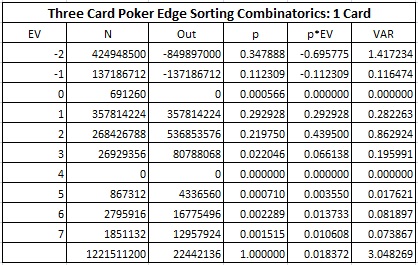
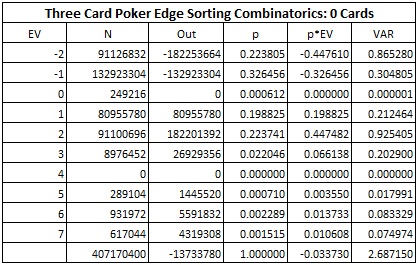
In practice, a lot of things have to go right for the AP to be able to beat 3CP this way. The dealing procedure can't include a turn. The cards have to be spread on the felt to allow viewing all three cards. The cards have to be sortable. The APs have to occupy the table without other players joining. The dealer has to pick up the cards cleanly and consistently. The relief dealer has to be reliable too. But I can testify today to the fact that teams have targeted and beaten 3CP by edge sorting.
My advice for protecting 3CP from an "edge sorting" vulnerability are:
- Use a turn before putting the cards into the automatic shuffler.
- If the cards are manually shuffled, make sure the shuffle includes a turn.
- Do not spread the dealer's cards before the player's have made their play/fold decision.
- Watch for team play.
- Get better cards.


